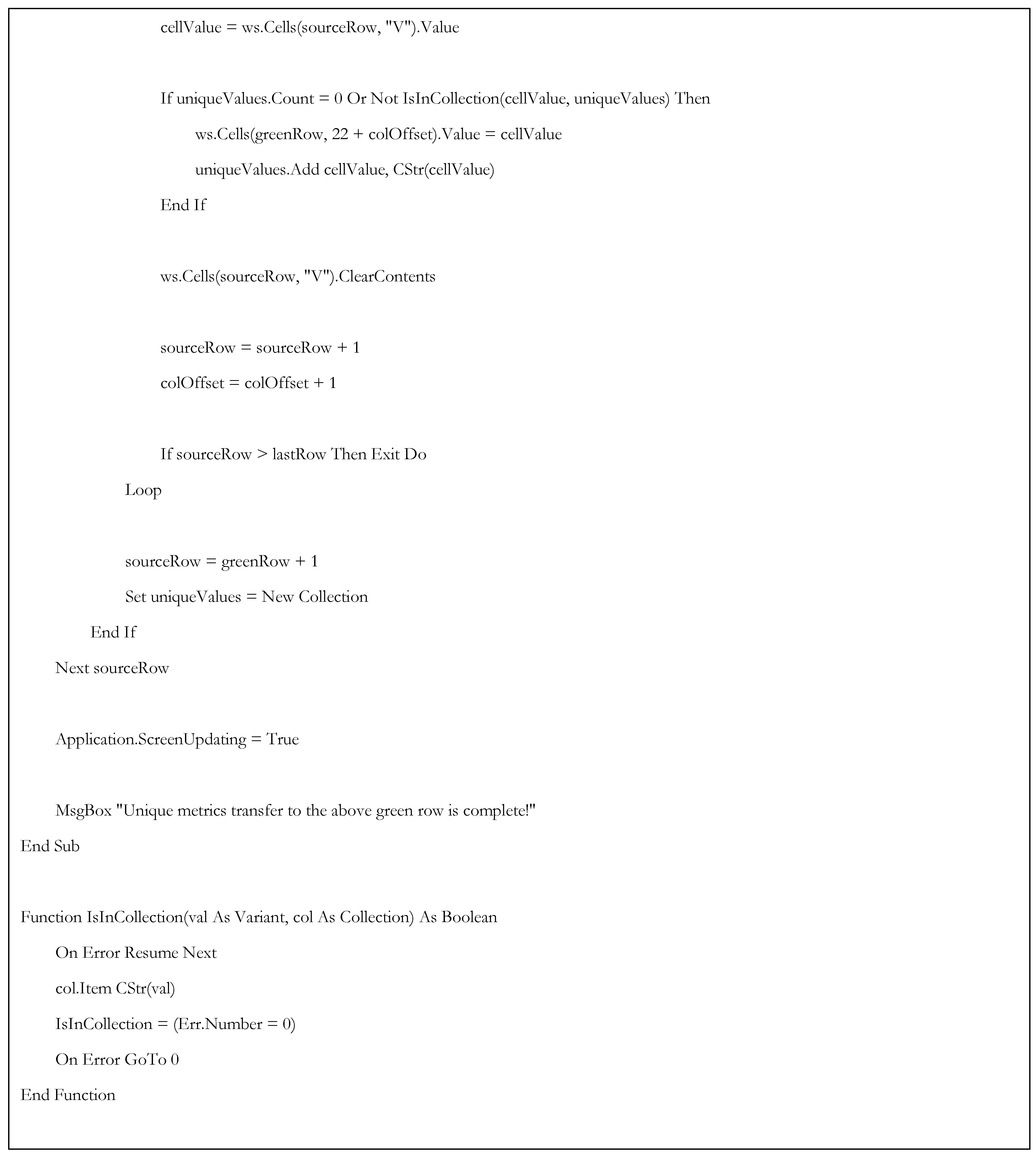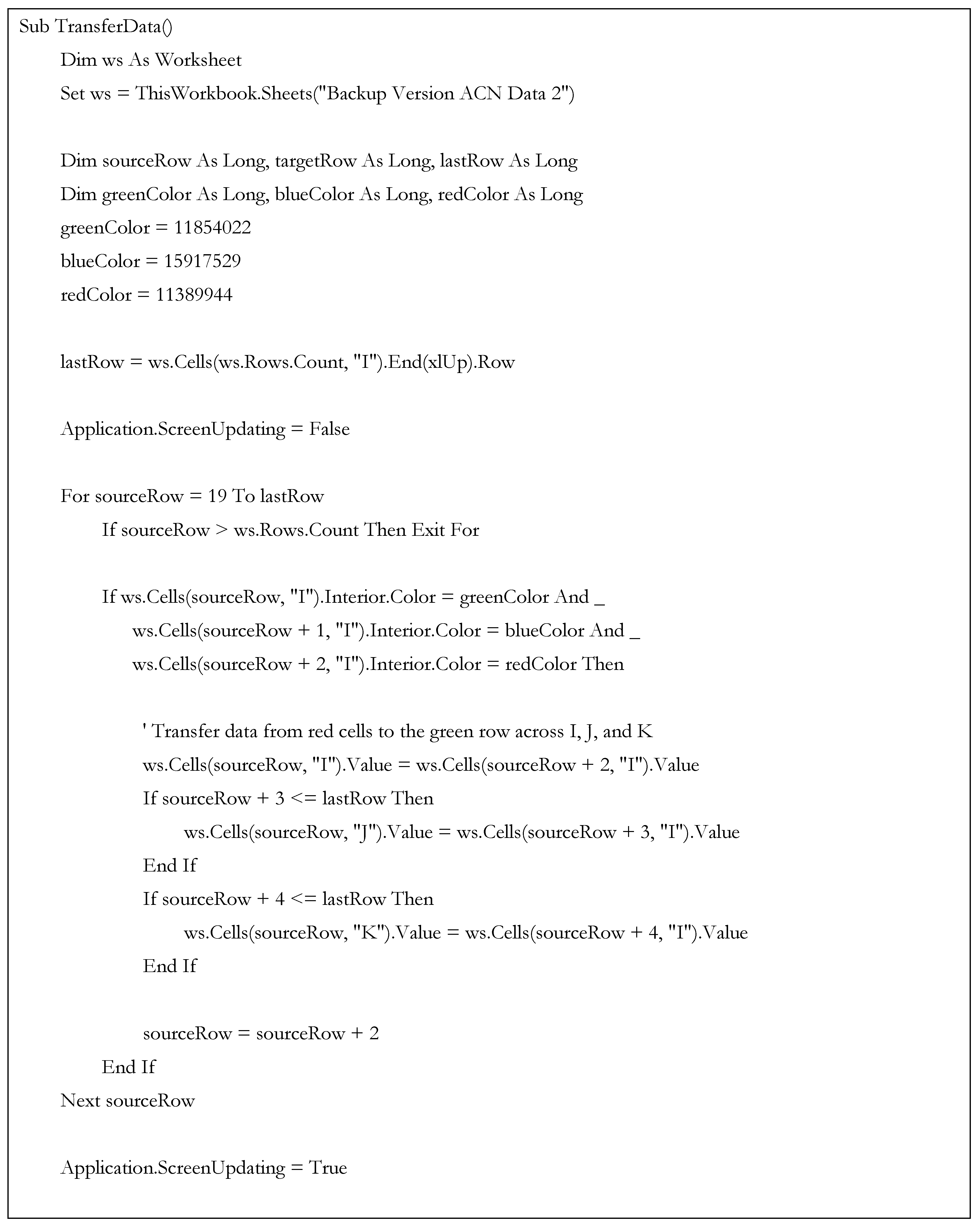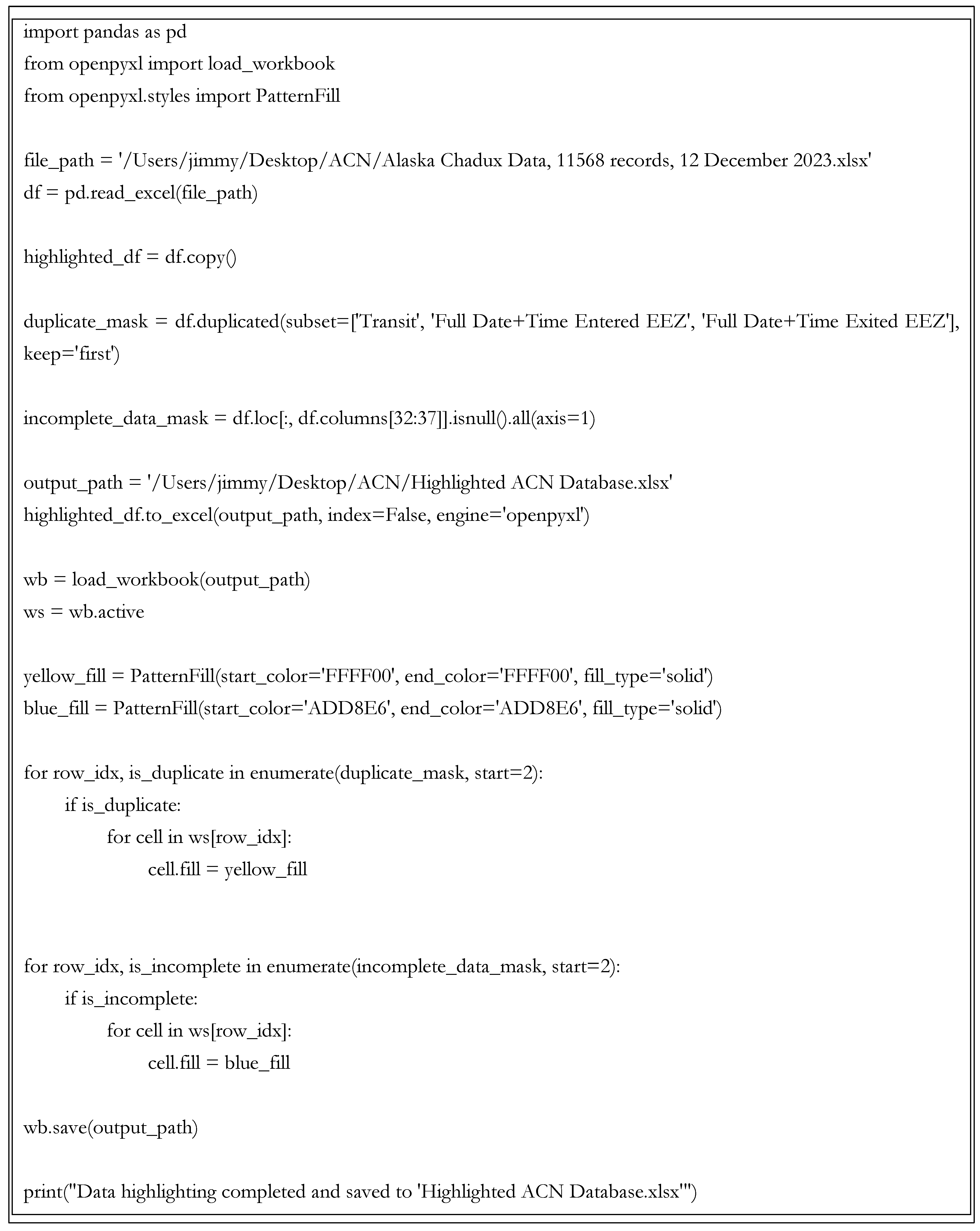Self-Healing Databases for Emergency Response Logistics in Remote and Infrastructure-Poor Settings
Abstract
:1. Introduction
2. Previous Work
3. Materials and Methods
3.1. Setting and Background
3.2. Approach
3.3. Data
3.4. Method
4. Analysis and Results
5. Discussion
- Improved data quality, as missing, incomplete, and redundant data were identified and resolved using the neural net’s classification algorithm;
- Improved data analysis processes, particularly with data cleaning tasks, compared to the use of automated anomaly detection scripts;
- Improved support for real-time data anomaly and inconsistency detection, as inconsistent, conflicting, and missing data were automatically flagged with the use of the classification algorithm;
- Improved utilization of scarce human resources, who could supervise and review the results of the automated data anomaly detection, diagnosis, and correction processes, rather than engage in time-consuming, cumbersome, and error-prone human data cleaning and review processes.
Author Contributions
Funding
Data Availability Statement
Acknowledgments
Conflicts of Interest
Appendix A







Appendix B


References
- Dale, R.F.; Gross, L. The Arctic: Last Frontier for Energy and Mineral Exploitation? In Handbook on International Development and the Environment; Edward Elgar Publishing: Cheltenham, UK, 2023; pp. 154–169. Available online: https://www.elgaronline.com/edcollchap/book/9781800883789/book-part-9781800883789-18.xml (accessed on 4 November 2024).
- Kuletz, K.J.; Ferguson, S.H.; Frederiksen, M.; Gallagher, C.P.; Hauser, D.D.; Hop, H.; Kovacs, K.M.; Lydersen, C.; Mosbech, A.; Seitz, A.C. A review of climate change impacts on migration patterns of marine vertebrates in Arctic and Subarctic ecosystems. Front. Environ. Sci. 2024, 12, 1434549. [Google Scholar] [CrossRef]
- Vogler, R.; Stoll, C. Transforming local Arctic tourism businesses in times of multiple crises: A post-pandemic perspective. Polar Geogr. 2024, 47, 33–48. [Google Scholar] [CrossRef]
- Hu, W.; Cervone, G.; Trusel, L.; Yu, M. Arctic accessibility: Recent trend in observed ship tracks and validation of Arctic transport accessibility model. Ann. GIS 2024, 30, 455–4740. [Google Scholar] [CrossRef]
- World Wildlife Fund. Safety at the Helm: A Plan for Smart Shipping Through the Bering Strait; World Wildlife Fund-Anchorage: Anchorage, Alaska, 2020; Available online: https://www.worldwildlife.org/pages/safety-at-the-helm-a-plan-for-smart-shipping-through-the-bering-strait (accessed on 8 September 2024).
- Northern Sea Route Information Office. NSR Shipping Traffic—Activities in May 2022; Nord University: Bodø, Norway, 2022; Available online: https://arctic-lio.com/nsr-shipping-traffic-activities-in-may-2022/ (accessed on 8 September 2024).
- Humpert, First Panamax Containership Sprints Across Arctic Reaching China in Just Three Weeks. gCaptain. 25 September 2024. Available online: https://gcaptain.com/first-panamax-containership-sprints-across-arctic-reaching-china-in-just-three-weeks/ (accessed on 1 November 2024).
- Staalesen, A. Chinese Heavy Lift Ship Without Ice-Class Battles on Freezing Arctic Route. Barents Observer. 30 October 2024. Available online: https://www.thebarentsobserver.com/news/chinese-heavy-lift-ship-without-iceclass-battles-on-freezing-arctic-route/419719 (accessed on 2 November 2024).
- National Research Council; Transportation Research Board; Marine Board; Division on Earth; Life Studies; Polar Research Board; Ocean Studies Board; Committee on Responding to Oil Spills in the US Arctic Marine Environment. Responding to Oil Spills in the US Arctic Marine Environment; National Academies Press: Cambridge, MA, USA, 2014. [CrossRef]
- O’Rourke, R.; Comay, L.B.; Frittelli, J.; Kaboli, E.; Keating-Bitonti, C.; Marshak, A.R.; Ramseur, J.L.; Ryan, L.; Sheikh, P.A. Changes in the Arctic: Background and Issues for Congress; Report R41153; Congressional Research Service: Washington, DC, USA, 2024. Available online: https://crsreports.congress.gov/product/details?prodcode=R41153 (accessed on 8 August 2024).
- Johannsdottir, L.; Cook, D. Systemic risk of maritime-related oil spills viewed from an Arctic and insurance perspective. Ocean Coast. Manag. 2019, 179, 104853. [Google Scholar] [CrossRef]
- Das, T.; Goerlandt, F.; Pelot, R. A mixed integer programming approach to improve oil spill response resource allocation in the Canadian Arctic. Multimodal Transp. 2024, 3, 100110. [Google Scholar] [CrossRef]
- Zhong, Z.; You, F. Oil spill response planning with consideration of physicochemical evolution of the oil slick: A multiobjective optimization approach. Comput. Chem. Eng. 2011, 35, 1614–1630. [Google Scholar] [CrossRef]
- Matveev, A.; Bogdanova, E. Functional model of an intelligent decision support system for responding to transport emergencies in the Arctic zone. Transp. Res. Procedia 2021, 57, 363–369. [Google Scholar] [CrossRef]
- Fingas, M.F.; Hollebone, B.P. Review of behaviour of oil in freezing environments. Mar. Pollut. Bull. 2003, 47, 333–340. [Google Scholar] [CrossRef] [PubMed]
- Paardenkooper, K. The role of data-driven logistics in Arctic shipping. In Arctic Maritime Logistics: The Potentials and Challenges of the Northern Sea Route; Springer International Publishing: Cham, Switzerland, 2022; pp. 173–191. Available online: https://link.springer.com/chapter/10.1007/978-3-030-92291-7_10 (accessed on 1 November 2024).
- Andreassen, N.; Borch, O.J. (Eds.) Crisis and Emergency Management in the Arctic: Navigating Complex Environments; Routledge: London, UK, 2020. [Google Scholar]
- Camur, M.C.; Sharkey, T.C.; Dorsey, C.; Grabowski, M.R.; Wallace, W.A. Optimizing the Response for Arctic Mass Rescue Events. Transp. Res. Part E Logist. Transp. Rev. 2021, 152, 102368. [Google Scholar] [CrossRef]
- Kelman, I.; Loe, J.S.P.; Rowe, E.W.; Wilson, E.; Poussenkova, N.; Nikitina, E.; Fjærtoft, D.B. Local perceptions of corporate social responsibility for Arctic petroleum in the Barents region. Arct. Rev. Law Politics 2016, 2, 152–178. [Google Scholar] [CrossRef]
- Grabowski, M.R.; Rizzo, C.; Graig, T. Data challenges in dynamic, large-scale resource allocation in remote regions. Saf. Sci. 2016, 87, 76–86. [Google Scholar] [CrossRef]
- Barker, C.H.; Kourafalou, V.H.; Beegle-Krause, C.; Boufadel, M.; Bourassa, M.A.; Buschang, S.G.; Androulidakis, Y.; Chassignet, E.P.; Dagestad, K.-F.; Danmeier, D.G.; et al. Progress in operational modeling in support of oil spill response. J. Mar. Sci. Eng. 2020, 8, 668. [Google Scholar] [CrossRef]
- Yang, Z.; Chen, Z.; Lee, K.; Owens, E.; Boufadel, M.C.; An, C.; Taylor, E. Decision support tools for oil spill response (OSR-DSTs): Approaches, challenges, and future research perspectives. Mar. Pollut. Bull. 2021, 167, 112313. [Google Scholar] [PubMed]
- U.S. Government Accountability Office. Coast Guard: Complete Performance and Operational Data Would Clarify Arctic Resource Needs. GAO-24-106491; U.S. Government Accountability Office: Washington, DC, USA, 2024. Available online: https://www.gao.gov/products/gao-24-106491 (accessed on 5 September 2024).
- Hanga, K.M.; Kovalchuk, Y. Machine learning and multi-agent systems in oil and gas industry applications: A survey. Comput. Sci. Rev. 2019, 34, 100191. [Google Scholar] [CrossRef]
- Odimarha, A.C.; Ayodeji, S.A.; Abaku, E.A. Machine learning’s influence on supply chain and logistics optimization in the oil and gas sector: A comprehensive analysis. Comput. Sci. IT Res. J. 2024, 5, 725–740. [Google Scholar] [CrossRef]
- Kruke, B.I.; Auestad, A.C. Emergency preparedness and rescue in Arctic waters. Saf. Sci. 2021, 136, 105163. [Google Scholar] [CrossRef]
- American Petroleum Institute; National Oceanic & Atmospheric Administration; U.S. Coast Guard; U.S. Environmental Protection Agency. A Guide for Spill Response Planning in Marine Environments; U.S. Coast Guard: Washington, DC, USA, 2001. Available online: https://homeport.uscg.mil/Lists/Content/Attachments/75984/Guide%20for%20Spill%20Response%20Planning%20in%20Marine%20Environment.pdf (accessed on 20 August 2024).
- Wright, S.K.; Wilkin, S.M.; Jensen, A.S.; Rowles, T.K.; Dushane, J.; Ziccardi, M. Arctic Marine Mammal Disaster Response Guidelines: National Marine Fisheries Service Guidance Report; National Oceanic and Atmospheric Administration: Washington, DC, USA, 2017. Available online: https://repository.library.noaa.gov/view/noaa/16986/noaa_16986_DS3.pdf (accessed on 4 November 2024).
- Roud, E.; Gausdal, A.H. Trust and emergency management: Experiences from the Arctic Sea region. J. Trust Res. 2019, 9, 203–225. [Google Scholar] [CrossRef]
- Ocean Conservancy. Arctic Alaska: Oil Spill Prevention and Response Requirements Primer; Nuka Research & Planning Group: Seldovia, Alaska, 2020; Available online: https://oceanconservancy-org.webpkgcache.com/doc/-/s/oceanconservancy.org/wp-content/uploads/2020/07/200702-OC-Arctic-AK-Guide-SCREEN-vf.pdf (accessed on 20 August 2024).
- Grabowski, M.R.; Martelli, P.F.; Roberts, K.H. Reliability-Seeking virtual organizations at the margins of systems, resources and capacity. Saf. Sci. 2023, 168, 106327. [Google Scholar] [CrossRef]
- Farshadfar, Z.; Mucha, T.; Tanskanen, K. Leveraging Machine Learning for Advancing Circular Supply Chains: A Systematic Literature Review. Logistics 2024, 8, 108. [Google Scholar] [CrossRef]
- Ranran, L.; Lv, Z.; Dang, S.; Su, T.; Li, X. Application of machine learning in ocean data. Multimed. Syst. 2023, 29, 1815–1824. [Google Scholar] [CrossRef]
- Schneider, C.; Barker, A.; Dobson, S. A survey of self-healing systems frameworks. Softw. Pract. Exp. 2015, 45, 1375–1398. [Google Scholar]
- Mozaffari, M.; Dignös, A.; Gamper, J.; Störl, U. Self-tuning Database Systems: A Systematic Literature Review of Automatic Database Schema Design and Tuning. ACM Comput. Surv. 2024, 56, 277. [Google Scholar] [CrossRef]
- Panwar, V. AI-driven query optimization: Revolutionizing database performance and efficiency. Int. J. Comput. Trends Technol. 2024, 72, 18–26. [Google Scholar] [CrossRef]
- Al-Jumeily, D.; Hussain, A.; Fergus, P. Using adaptive neural networks to provide self-healing autonomic software. Int. J. Space-Based Situated Comput. 2015, 5, 129–140. [Google Scholar] [CrossRef]
- Ahmed, S.; Ahamed, S.I.; Sharmin, M.; Haque, M.M. Self-healing for autonomic pervasive computing. In Proceedings of the 2007 ACM Symposium on Applied Computing, Seoul, Republic of Korea, 11–15 March 2007; pp. 110–111. [Google Scholar] [CrossRef]
- Shukla, S.K.; Pant, B.; Viriyasitavat, W.; Verma, D.; Kautish, S.; Dhiman, G.; Kaur, A.; Srihari, K.; Mohanty, S.N. An integration of autonomic computing with multicore systems for performance optimization in Industrial Internet of Things. IET Commun. 2022. early view. [Google Scholar] [CrossRef]
- Mohammadiun, S.; Hu, G.; Gharahbagh, A.A.; Li, J.; Hewage, K.; Sadiq, R. Intelligent computational techniques in marine oil spill management: A critical review. J. Hazard. Mater. 2021, 419, 126425. [Google Scholar] [CrossRef]
- Comfort, L.K. Self-organization in complex systems. J. Public Adm. Res. Theory J-PART 1994, 3, 393–410. [Google Scholar]
- Shatnawi, A.; Faye, E.; Rima, B.; Al Shara, Z.; Seriai, A.-D. The State of the Art of Emergent Software Systems. IEEE Access 2024, 12, 31808–31823. [Google Scholar] [CrossRef]
- Patil, A.; Rane, M. Convolutional neural networks: An overview and its applications in pattern recognition. In Proceedings of the Information and Communication Technology for Intelligent Systems: Proceedings of ICTIS 2020, Ahmedabad, India, 15–16 May 2020; Volume 1, pp. 21–30. [Google Scholar] [CrossRef]
- Sekar, J.; Aquilanz, L.L.C. Autonomous Cloud Management Using AI: Techniques for Self-Healing and Self-Optimization. J. Emerg. Technol. Innov. Res. 2023, 11, 571–580. [Google Scholar]
- Zawish, M.; Dharejo, F.A.; Khowaja, S.A.; Raza, S.; Davy, S.; Dev, K.; Bellavista, P. AI and 6G into the metaverse: Fundamentals, challenges and future research trends. IEEE Open J. Commun. Soc. 2024, 5, 730–778. [Google Scholar] [CrossRef]
- Ghahremani, S.; Giese, H. Evaluation of self-healing systems: An analysis of the state-of-the-art and required improvements. Computers 2020, 9, 16. [Google Scholar] [CrossRef]
- U.S. Congress. Oil Pollution Act of 1990 [PDF File]. 1990. Available online: https://www.bsee.gov/sites/bsee.gov/files/federal-register-notice/presentations/opa90.pdf (accessed on 29 February 2024).
- Mathew, R. 30 Years Removed, Oil-Spill Liability Insurance’s Evolution Since the 1989 Exxon Valdez Incident. Ocean Coast. Law J. 2024, 29, 25. [Google Scholar]
- Alaska Regional Response Team (RRT). Alaska Regional Contingency Plan (Version 2) [PDF]. 2022. Available online: https://nrt.org/sites/176/files/Alaska_RCP_V2_2022FEB.pdf (accessed on 7 November 2024).
- Ivshina, I.B.; Kuyukina, M.S.; Krivoruchko, A.V.; Elkin, A.A.; Makarov, S.O.; Cunningham, C.J.; Peshkur, T.A.; Atlas, R.M.; Philp, J.C.; 2015. Oil spill problems and sustainable response strategies through new technologies. Environ. Sci. Process. Impacts 2015, 17, 1201–1219. [Google Scholar] [CrossRef]
- Lee, G.Y.; Alzamil, L.; Doskenov, B.; Termehchy, A. A survey on data cleaning methods for improved machine learning model performance. arXiv 2021, arXiv:2109.07127. [Google Scholar]
- Ash, J. Flying against the clock–risk management and resilience in Arctic search and rescue and casualty evacuation flights. Saf. Extrem. Environ. 2023, 5, 79–89. [Google Scholar] [CrossRef]
- Wilkinson, J.; Beegle-Krause, C.J.; Evers, K.U.; Hughes, N.; Lewis, A.; Reed, M.; Wadhams, P. Oil spill response capabilities and technologies for ice-covered Arctic marine waters: A review of recent developments and established practices. Ambio 2017, 46 (Suppl. S3), S423–S441. [Google Scholar] [CrossRef] [PubMed]
- Clark, D.G.; Ford, J.D.; Tabish, T. What role can unmanned aerial vehicles play in emergency response in the Arctic: A case study from Canada. PLoS ONE 2018, 13, e0205299. [Google Scholar] [CrossRef]
- Knol, M.; Arbo, P. Oil spill response in the Arctic: Norwegian experiences and future perspectives. Mar. Policy 2014, 50, 171–177. [Google Scholar] [CrossRef]
- Turoff, M.; Chumer, M.; de Walle, B.V.; Yao, X. The design of a dynamic emergency response management information system (DERMIS). J. Inf. Technol. Theory Appl. (JITTA) 2004, 5, 3. [Google Scholar]
- Hristidis, V.; Chen, S.C.; Li, T.; Luis, S.; Deng, Y. Survey of data management and analysis in disaster situations. J. Syst. Softw. 2010, 83, 1701–1714. [Google Scholar] [CrossRef]
- McMillan, L.; Varga, L. Towards self-healing in water infrastructure systems. Proc. Inst. Civ. Eng.-Smart Infrastruct. Constr. 2022, 176, 53–61. [Google Scholar] [CrossRef]
- Hazel, W.E.B. Leveraging Advanced Information Technologies and Artificial Intelligence Applications to Enhance Situational Awareness: New and Future Models for Oil Spill Prevention, Preparedness and Response. In Proceedings of the International Oil Spill Conference Proceedings, New Orleans, LA, USA, 13–16 May 2024; Allen Press: Lawrence, KS, USA, 2024. [Google Scholar]
- Remil, Y.; Bendimerad, A.; Mathonat, R.; Kaytoue, M. AIops solutions for incident management: Technical guidelines and a comprehensive literature review. arXiv 2024, arXiv:2404.01363. [Google Scholar]
- Edwards, P.N.; Mayernik, M.S.; Batcheller, A.L.; Bowker, G.C.; Borgman, C.L. Science Friction: Data, Metadata, and Collaboration. Soc. Stud. Sci. 2011, 41, 667–690. [Google Scholar] [CrossRef]
- Cucinelli, J.; Goerlandt, F.; Pelot, R. Exploring Risk Governance Deficits for Marine Oil Spill Preparedness and Response in Canada. In Area-Based Management of Shipping: Canadian and Comparative Perspectives; Springer Nature: Cham, Switzerland, 2024; pp. 227–260. [Google Scholar] [CrossRef]
- Deng, F.; Tao, X.; Wei, P.; Shiyin Wei, S. A robust deep learning-based damage identification approach for SHM considering missing data. Appl. Sci. 2023, 13, 5421. [Google Scholar] [CrossRef]
- Jerez, J.M.; Molina, I.; García-Laencina, P.J.; Alba, E.; Ribelles, N.; Martín, M.; Franco, L. Missing data imputation using statistical and machine learning methods in a real breast cancer problem. Artif. Intell. Med. 2010, 50, 105–115. [Google Scholar] [CrossRef]
- Angelopoulos, A.; Michailidis, E.T.; Nomikos, N.; Trakadas, P.; Hatziefremidis, A.; Voliotis, S.; Zahariadis, T. Tackling faults in the industry 4.0 era—A survey of machine-learning solutions and key aspects. Sensors 2019, 20, 109. [Google Scholar] [CrossRef]
- Lakshminarayan, K.; Harp, S.A.; Samad, T. Imputation of missing data in industrial databases. Appl. Intell. 1999, 11, 259–275. [Google Scholar] [CrossRef]

| Data Identification | Data Attributes |
|---|---|
| 1 | Vessel ID (MMIC) |
| 2 | Vessel Name |
| 3 | Last port of call (LPOC) |
| 4 | Next port of call (NPOC) |
| 5 | Intended route |
| 6 | Estimated date of arrival |
| 7 | Estimated time of arrival |
| 8 | Fuel oil type |
| 9 | Fuel oil quantity |
| 10 | Lube oil type |
| 11 | Lube oil quantity |
| 12 | Cargo on board (type) |
| 13 | Cargo volume |
| 14 | Location of last fuel received |
| 15 | Exhaust scrubber installed? (yes/no) |
| 16 | Vessel contact information—Email |
| 17 | Vessel contact information—Phone |
| 18 | Intended route deviating from routing measures? (yes/no) |
| 19 | On board Automated Identification System functioning? (yes/no) |
| 20 | On board Automated Identification System tested? (yes/no) |
| 21 | On board Automated Identification System date tested |
| Vessel Type | Number of Vessels (2023) | Percentage |
|---|---|---|
| Break Bulk | 5 | 0.2% |
| Bulk Carrier | 981 | 47.9% |
| Bulk/Container | 59 | 2.9% |
| Container | 684 | 33.4% |
| Heavy Lift | 3 | 0.1% |
| LNG/LPG | 36 | 1.8% |
| Passenger | 85 | 4.2% |
| Refrigerated Cargo | 36 | 1.8% |
| RoRo | 9 | 0.4% |
| Tug/Offshore Supply Vessel | 1 | 0.0% |
| Vehicle Carrier | 149 | 7.3% |
| Total | 2048 |
| Types of Records | Number of Records | Percentage of Original Dataset |
|---|---|---|
| Initial number of records | 11,568 | |
| Duplicative records | 6490 | 56.10% |
| Incomplete records | 118 | 1.02% |
| Incomplete oil records | 2891 | 24.99% |
| Final dataset (eliminating duplicate, incomplete records) | 2069 | 17.89% |
| Phases | Automated Anomaly Detection Hours (Scripts) | Self Healing Hours (Neural Nets) | Process Improvement (% Change in Hours) |
|---|---|---|---|
| Data Collection | 0 | 0 | - |
| Data Cleaning | 120 | 26 | 78.33% |
| Data Analysis | 16 | 16 | - |
| Total | 136 | 42 | 69.1% |
Disclaimer/Publisher’s Note: The statements, opinions and data contained in all publications are solely those of the individual author(s) and contributor(s) and not of MDPI and/or the editor(s). MDPI and/or the editor(s) disclaim responsibility for any injury to people or property resulting from any ideas, methods, instructions or products referred to in the content. |
© 2025 by the authors. Licensee MDPI, Basel, Switzerland. This article is an open access article distributed under the terms and conditions of the Creative Commons Attribution (CC BY) license (https://creativecommons.org/licenses/by/4.0/).
Share and Cite
McGarvey, J.; Grabowski, M.R.; Custard, B.; Gabelein, S. Self-Healing Databases for Emergency Response Logistics in Remote and Infrastructure-Poor Settings. Logistics 2025, 9, 23. https://doi.org/10.3390/logistics9010023
McGarvey J, Grabowski MR, Custard B, Gabelein S. Self-Healing Databases for Emergency Response Logistics in Remote and Infrastructure-Poor Settings. Logistics. 2025; 9(1):23. https://doi.org/10.3390/logistics9010023
Chicago/Turabian StyleMcGarvey, James, Martha R. Grabowski, Buddy Custard, and Steven Gabelein. 2025. "Self-Healing Databases for Emergency Response Logistics in Remote and Infrastructure-Poor Settings" Logistics 9, no. 1: 23. https://doi.org/10.3390/logistics9010023
APA StyleMcGarvey, J., Grabowski, M. R., Custard, B., & Gabelein, S. (2025). Self-Healing Databases for Emergency Response Logistics in Remote and Infrastructure-Poor Settings. Logistics, 9(1), 23. https://doi.org/10.3390/logistics9010023






